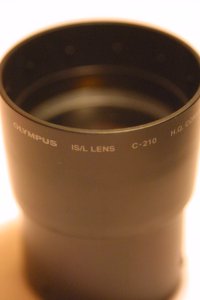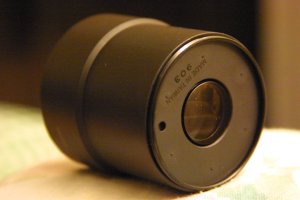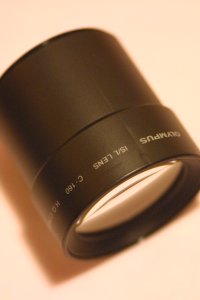Using the Olympus C-160 and C-210 Teleconverters on various cameras and camcorders

The Olympus C-160 and C-210 Teleconverters, 1.45x and 1.9x respectively, were originally designed for Olympus 35mm ZLR cameras. ZLR stood for Zoom Lens Reflex and was the designation for a series of Olympus, non-interchangeable lens, SLR cameras. These teleconverters were specifically made to work with the following Olympus models:
IS-30 DLX, IS-300, L-30
IS-20 DLX, IS-200, L-20
IS-10 Super DLX, IS-100s, L-10 Super IS-10, IS-100, L-10
These teleconverters include front and rear lens caps, lens pouch, and instruction manual. The C-210 model even comes with a built-in lens hood that snaps into place. These teleconverters mount to the Olympus ZLR cameras via 52mm filter threads. When these two teleconverters are used on these cameras, they would achieve maximum focal length of 160mm and 210mm, respectively; hence their model names.
Goal
I came across these teleconverters one day, hoping they would work with my camera equipment. The goal was to experiment and get them to work with my digital, APS, and 35mm system.
These teleconverters have rear lens element that are much smaller than 52mm (see picture), so I had a feeling that they will vignette the final results. I was both excited and disappointed that they vignette in some configuration and not in others. Successes failures are mixed . . . read on.
Teleconverter Light-Loss
Unlike the Olympus 1.45x teleconverter specifically designed for the C-2500L camera (see article in review section), the C-160 and C-210 teleconverters do cause metered light-loss. The C-160 loses about one stop of light and the C-210 loses about two stops of light. These light-losses are fairly typical of teleconverters (see my "Stacking Teleconverters" article).
Olympus C-2500L Digital Camera
The Olympus C-2500L is a ZLR digital camera. Despite my less then glowing review of this camera (see article in review section), it is a good camera and I use it quite often. I really want to get these teleconverters to work with this camera. Unlike my Canon EOS cameras, the lens on this Olympus camera is not interchangeable, so I can't just throw a 300mm lens on it. The C-2500L has a maximum focal length of 110mm (35mm equivalent). With the 1.9x teleconverter the focal length could be extended to 209mm, providing a more compressed field-of-view.
I attached the teleconverters to the C-2500L camera with a 43-52mm step-up ring. Everything looked good through the viewfinder. However, upon reviewing the pictures, I found slight vignette in all four corners of the picture.
|
|
Shot with C-2500L. |
|
|
Shot with C-2500L and C-160. |
|
|
Shot with C-2500L and C-210. |
The sample images, above, show this effect. In this case, we wanted the audience to focus on the model, so the light fall-off, in the corners, actually worked for this subject. But in general, the light fall-off is not a desirable effect.
Canon EOS D30 Digital Camera
These teleconverters worked well with my D30 camera and my EF lenses. At least ones with 52mm filter threads anyway. These teleconverters worked well with this camera because the camera sensor is smaller than a 35mm film frame (which the EF lenses are designed for). The smaller sensor causes a 1.6x magnification and does not use the entire area of the EF lens element. Therefore, less likely to vignette.
I put the 1.9x teleconverter on my Canon 55-200mm f/4.5-5.6 USM lens and was able to get, a whopping, 380mm focal length just from the lens and the teleconverter. Adding the sensor magnification, this configuration gives me 608mm total focal length.
Although this configuration works for me, it is not as desirable as if the C-2500L configuration had worked. I have a Canon EF 300mm f/4 lens and several EOS rear-mount teleconvertes so I could already accomplished this feat. For those of you without the hefty lenses that I have, this is a good-value-for-the-price solution. I do have to admit that these front-mount teleconverters are a lot more convenient then rear-mount teleconverters, so the value is even better.
Canon EOS IX APS Camera

APS film also have a small frame size than 35mm film. Its magnification factor is 1.25x. Luckily the IX camera also uses EF lenses. Conventional wisdom tells me that this configuration will work with these Olympus teleconverters. The convention wisdom is somewhat correct. The same experience I had with the D30 and these teleconverters apply to the IX in most cases. Here are the details of each configuration:
Canon EF 28mm f/2.8: This lens is too wide. The teleconverters causes light fall-off on the two long ends of the picture frame. This trait can be used for framing the subject.
Canon EF 50mm f/1.8 II: On this lens, the teleconverters work great. The C-160 changes the focal length of this lens to 72.5 in addition to the 1.25x magnification caused by the APS format. The C-210 changes the focal length to 95mm in addition to the 1.25x magnification.
Canon EF 55-200mm f/4-5.6 USM: Between 55mm and 100mm, both teleconverters show slight vignette around the corners of the viewfinder. But both teleconverters were completely useable between 100mm and 200mm on this lens. With the C-160, this translates to 145mm and 290mm. With the C-210, this translates to 190mm and 380mm. These translations are in addition to the 1.25 magnification caused by the APS format.
Canon EOS Rebel XS 35mm Camera

The Olympus teleconverters did not work very well with this 35mm camera and most EF lenses. However, it did work fine with the EF 55-200mm lens at the long focal end. Here are more details of each configuration:
Canon EF 28mm f/2.8: This lens is too wide. The teleconverters are useable on this lens if you would like to frame your subject in a circle surrounded by darkness.
Canon EF 50mm f/1.8 II: On this lens, both teleconverters shows large vignettes around the corners of the viewfinder.
Canon EF 55-200mm f/4-5.6 USM: Between 55mm and 135mm, both teleconverters show large black halo around the picture frame. But both teleconverters were completely useable between 135mm and 200mm on this lens. With the C-160, this translates to 195.75mm and 290mm. With the C-210, this translates to 256.5mm and 380mm.
Panasonic PV-GS50S MiniDV Camcorder
|
|
The Olympus C-210 teleconverter mounted on the Panasonic PV-GS50S camcorder at the widest view shows that the rocks are very far away from us. Details of the rocks cannot be seen by the naked eye. |
|
|
The Olympus C-210 teleconverter mounted on the Panasonic PV-GS50S camcorder at full optical zoom. It shows the rocks very clearly with a dozen of sea lions tanning under the warm sun. The 1.9x teleconverter combined with the camcorder's 10x optical zoom provided 19x optical zoom! |
Sony CCD-V9 Video8 Handycam
I had added this section a few months ago. But the data was lost due to a server crash. I am in the process of reconstructing this section.Sony DCR-TRV350 Digital8 Handycam
After having used my Canon EOS cameras for so many years, I have became spoiled by the fact that I can easily change lenses on the EOS systems to get different perspectives of the scene. I have wished that this flexibility is available on consumer-level camcorders also. Unfortunately, that is not the case and the only way to change perspective on a camcorder is through its zoom function. If the perspective that you want is out of your zoom range, than you will need to use attachment lenses.
Luckily for me, both of these Olympus teleconverters worked well with the Sony DCR-TRV350 Digital8 Handycam. With the setting at wide angle (fully zoomed out), the teleconverters creates a round black halo around the video. But when the camcorder is set to its maximum zoom-in setting, the teleconverters increased magnification and did not vignette the video.
The Sony DCR-TRV350 Digital8 Handycam supported 20x optical zoom. With the 1.45x teleconverter, the final optical magnification becomes 29x. With the 1.9x teleconverter, the final optical magnification becomes 38x. This Handycam also comes with a potent digital zoom: 700x. Personally, I never use digital zoom. But if we were to calculate the final digital zoom magnification, they would be 1015x and 1330x.
Although the C-210 teleconverter seems to require a longer minimum focus distance than the C-160 teleconverter on this camcorder, this trait is normal with longer teleconverter lenses.
Sony DSC-P92 Digital Camera / Sony VAD-PEA Lens Adapter
The Sony DSC-P92 digital camera does not have any filter threads for attaching accessory lenses. However, with a Sony VAD-PEA lens adapter (reviewed elsewhere on this site), filters and accessory lenses can be attached to this digital camera. The Sony VAD-PEA has a 30mm filter thread, so a step-up ring is need to attach the Olympus teleconverters. I chose to use a 30mm-37mm and a 37-52mm step-up rings for this purpose. Both C-160 and C-210 teleconverters improved the digital camera zoom and showed great results.
[Awaiting sample pictures.]
Related Links
- Olympus 200-540 1.45X Teleconverter Lens - Amazon User Reviews
- Olympus America Inc.
- Olympus Conversion Lenses
- Olympus Global
- Panasonic USA
- Panasonic PV-GS50S MiniDV Ultra Compact Digital Palmcorder (Silver) - Amazon User Reviews
- SonyStyle
- Sony DCR-TRV350 Digital8 Camcorder - Amazon User Reviews
- Sony DSC-P92 Cyber-shot 5MP Digital Camera - Amazon User Reviews
- Sony VAD-PEA Conversion Lens Adaptor Mount - Amazon User Reviews
212 Users Online
|
$10000-above $5000-$9999 $2000-$4999 $1000-$1999 $500-$999 $200-$499 $100-$199 $50-$99 $25-$49 $0-$24 Gift Certificate |
|


